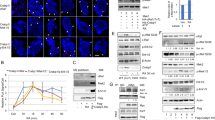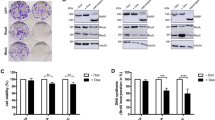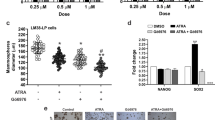Abstract
In the MCF-7 breast cancer cell line, insulin-like growth factors (IGFs) are known to elicit antiproliferative actions via the insulin receptor substrate-1 (IRS-1)/PI 3-kinase/AKT pathway. All-trans retinoic acid (RA) is a potent inhibitor of MCF-7 cell proliferation, but the mechanism by which growth regulation is achieved remains unclear. We investigated the effects of RA on the regulation of the IGF-IR and its key signaling elements: IRS-1, IRS-2, and SHC. Treatment of MCF-7 cells with RA caused a significant reduction in IRS-1 protein and tyrosine phosphorylation levels at a concentration and time consistent with RA-mediated growth inhibition. IRS-1 regulation is selective, as RA did not influence IRS-2 or SHC levels. Downstream signaling events were also selectively reduced, as RA abrogated IGF-I-stimulated AKT activation but did not alter erk1/2 activation. To confirm the importance of IRS-1 regulation by RA, we examined the response to RA in MCF-7 cells overexpressing IGF-IR and IRS-1. RA resistance was observed in MCF-7 cells overexpressing IRS-1 but not IGF-IR. This suggests that RA-mediated growth inhibition requires the selective downregulation of IRS-1 and AKT. Therapeutic agents targeting the IRS-1/PI 3-kinase/AKT pathway may enhance the cytostatic effects of RA in breast cancer, since overexpression of IRS-1 and AKT have been reported in primary breast tumors.
This is a preview of subscription content, access via your institution
Access options
Subscribe to this journal
Receive 50 print issues and online access
$259.00 per year
only $5.18 per issue
Buy this article
- Purchase on Springer Link
- Instant access to full article PDF
Prices may be subject to local taxes which are calculated during checkout






Similar content being viewed by others
References
Agadir A, Chen G, Bost F, Li Y, Mercola D and Zhang X . (1999). J. Biol. Chem., 274, 29779–29785.
Alessi DR, Andjelkovic M, Caudwell B, Cron P, Morrice N, Cohen P and Hemmings B . (1996). EMBO J., 15, 6541–6551.
Allen LF, Lenehan PF, Eiseman IA, Elliott WL and Fry DW . (2002). Semin. Oncol., 29, 11–21.
Ando S, Panno ML, Salerno M, Sisci D, Mauro L, Lanzino M and Surmacz E . (1998). Biochem. Biophys. Res. Commun., 253, 315–319.
Anzano MA, Byers SW, Smith JM, Peer CW, Mullen LT, Brown CC, Roberts AB and Sporn MB . (1994). Cancer Res., 54, 4614–4617.
Beitner-Johnson D and LeRoith D . (1995). J. Biol. Chem., 270, 5187–5190.
Blakesley VA, Kalebic T, Helman LJ, Stannard B, Faria TN, Roberts Jr CT and LeRoith D . (1996). Endocrinology, 137, 410–417.
Chang Q, Li Y, White MF, Fletcher JA and Xiao S . (2002). Cancer Res., 62, 6035–6038.
Cullen KJ, Yee D, Sly WS, Perdue J, Hampton B, Lippman ME and Rosen N . (1990). Cancer Res., 50, 48–53.
DeLuca ML . (1991). FASEB J., 5, 2924–2933.
de Vente JE, Carey JO, Byrant WO, Pettit GJ and Ways DK . (1996). J. Biol. Chem., 271, 32276–32280.
Dey BR, Frick K, Lopaczynski W, Nissley SP and Furlanetto RW . (1996). Mol. Endocrinol., 10, 631–641.
Dow R, Hendley J, Pirkmaier A, Musgrove EA and Germain D . (2001). J. Biol. Chem., 276, 45945–45951.
Downward J . (1995). Nature, 376, 553–554.
Dragnev KH, Rigas JR and Dmitrovsky E . (2000). Oncologist, 5, 361–368.
Dufourny B, Alblas J, van Teeffelen HA, van Schaik FM, van der Burg B, Steenbergh PH and Sussenbach JS . (1997). J. Biol. Chem., 272, 31163–31171.
Fontana JA, Burrows-Mezu A, Clemmons DR and LeRoith D . (1991). Endocrinology, 128, 1115–1152.
Franke T, Yang S, Chan TO, Datta K, Kazlauskas A, Morrison DK, Kaplan DR and Tsichilis PN . (1995). Cell, 81, 727–736.
Gianni M, Kopf E, Bastien J, Oulad-Abdelghani M, Garattini E, Chambon P and Rochette-Egly C . (2002). J. Biol. Chem., 277, 24859–24862.
Goalstone ML, Leitner JW, Berhanu P, Sharma PM, Olefsky JM and Draznin B . (2001). J. Biol. Chem., 276, 12805–12812.
Guruswamy S, Lightfoot S, Gold MA, Hassan R, Berlin KD, Ivey RT and Benbrook DM . (2001). J. Natl. Cancer Inst., 93, 516–525.
Guvakova MA and Surmacz E . (1997). Exp. Cell Res., 231, 149–162.
Ishibashi KI, Imamura T, Sharma PM, Huang J, Ugi S and Olefsky JM . (2001). J. Clin. Invest., 107, 1193–1202.
Jackson JG, White MF and Yee D . (1998). J. Biol. Chem., 273, 9994–10003.
Jackson JG, Zhang X, Yoneda T and Yee D . (2001). Oncogene, 20, 7318–7325.
Jones PF, Jakubowitz T, Pitossi FJ, Maurer F and Hemmings BA . (1991). Nature, 376, 599–602.
Kulik G, Klippel A and Weber MJ . (1997). Mol. Cell. Biol., 17, 1595–1606.
Lee AV, Jackson JG, Gooch JL, Hilsenbeck SG, Coronado-Heinsohn E, Osborne CK and Yee D . (1999). Mol. Endocrinol., 13, 787–796.
Lee J and Pilch PF . (1994). Am. J. Physiol., 266, C319–C334.
Li Q and Zhu GD . (2002). Curr Top Med. Chem., 2, 939–971.
Li XS, Chen JC, Sheikh MS, Shao ZM and Fontana JA . (1994). Exp. Cell Res., 211, 68–73.
Li Y and Sarkar FH . (2002). Clin. Cancer Res., 8, 2369–2377.
Liu Y, Lee MO, Wang HG, Li Y, Hashimoto Y, Klaus M, Reed JC and Zhang X . (1996). Mol. Cell. Biol., 16, 1138–1149.
Mauro L, Sisci D, Bartucci M, Salerno M, Kim J, Tam T, Guvakova MA, Ando S and Surmacz E . (1999). Exp. Cell Res., 252, 439–448.
Mitsiades CS, Mitsiades N, Poulaki V, Schlossman R, Akiyama M, Chauhan D, Hideshima T, Treon SP, Munshi NC, Richardson PG and Anderson KC . (2002). Oncogene, 21, 5673–5683.
Moon RC and Constantinou AI . (1997). Breast Cancer Res. Treatment, 46, 181–189.
Myers Jr MG, Wang LM, Sun XJ, Zhang Y, Yenush L, Schlessinger J, Pierce JH and White MF . (1994). Mol. Cell. Biol., 14, 3577–3587.
Nicholson KM and Anderson NG . (2002). Cell. Signal., 14, 381–395.
Nolan MK, Jankowska L, Prisco M, Xu S, Guvakova MA and Surmacz E . (1997). Int. J. Cancer, 72, 828–834.
O'Connor R, Fennelly C and Krause D . (2000). Biochem. Soc. Trans., 28, 47–51.
Pollak, M . (2000). Eur. J. Cancer, 36, 1224–1228.
Rocha RL, Hilsenbeck SG, Jackson JG, VanDenBerg CL, Weng CN, Lee AV and Yee D . (1997). Clin. Cancer Res., 3, 103–109.
Rosenauer A, Nervi C, Davison K, Lamph WW, Mader S and Miller Jr WH . (1998). Cancer Res., 58, 5110–5116.
Rozen F and Pollak M . (1999). Int. J. Oncol., 15, 589–594.
Rubin M, Fenig E, Rosenauer A, Menendez-Botet C, Achkar C, Bentel JM, Yahalom J, Mendelsohn J and Miller Jr WH . (1994). Cancer Res., 54, 6549–6556.
Sachdev D and Yee D . (2001). Endocr. Relat. Cancer, 8, 197–209.
Salerno M, Sisci D, Mauro L, Guvakova MA, Ando S and Surmacz E . (1999). Int. J. Cancer, 81, 299–304.
Shang Y, Baumrucker CR and Green MH . (1999). J. Biol. Chem., 274, 18005–18010.
Skolnik EY, Lee CH, Batzer A, Vicentini LM, Zhou M, Daly R, Myers Jr MJ, Backer JM, Ullrich A and White MF . (1993). EMBO J., 12, 1929–1936.
Spinella MJ, Freemantle SJ, Sekula D, Chang JH, Christie AJ and Dmitrovsky E . (1999). J. Biol. Chem., 274, 22013–22018.
Sporn MB, Roberts AB and Goodman DS . (1994). The Retinoids: Biology, Chemistry and Medicine. Raven Press: New York, pp. 573–595.
Strange R, Metcalfe T, Thackray L and Dang M . (2001). Microsc. Res. Tech., 52, 171–181.
Sueoka N, Lee HY, Walsh GL, Hong WK and Kurie JM . (1999). Cancer Res., 59, 3838–3844.
Sun XJ, Goldberg JL, Qiao LY and Mitchell JJ . (1999). Diabetes, 48, 1359–1364.
Sun XJ, Rothenberg P, Kahn CR, Backer JM, Araki E, Wilden PA, Cahill DA, Goldstein BJ and White MF . (1991). Nature, 352, 73–77.
Sun XJ, Wang LM, Zhang Y, Yenush L, Myers Jr MG, Glasheen E, Lane WS, Pierce JH and White MF . (1995). Nature, 377, 173–177.
Surmacz E and Burgaud JL . (1995). Clin. Cancer Res., 1, 1429–1436.
Tanaka T, Rodriquez de la Concepcion ML and De Luca LM . (2001). Biochem. Pharmacol., 61, 1347–1355.
Taouis M, Dupont J, Gillet A, Derouet M and Simon J . (1998). Mol. Cell. Endocrinol., 137, 177–186.
Tari AM, Lim SJ, Hung MC, Esteva FJ and Lopez-Berestein G . (2002). Oncogene, 21, 5224–5232.
Torrisi R, Decensi A, Formelli F, Camerini T and De Palo G . (2001). Drugs, 61, 909–918.
Veronesi U, De Palo G, Marubini E et al. (1999). J. Natl. Cancer Inst., 91, 1847–1856.
Wang Q, Yang W, Uytingco MS, Christakos S and Wieder R . (2000). Cancer Res., 60, 2040–2048.
Waters SB, Yamauchi K and Pessin JE . (1993). J. Biol. Chem., 268, 22231–22234.
White MF . (1997). Diabetologia, 40, S2–S17.
White MF and Kahn CR . (1994). J. Biol. Chem., 269, 1–4.
Xie SP, James SY and Colston KW . (1997). J. Endocrinol., 154, 495–504.
Xie SP, Pirianov G and Colston KW . (1999). Eur. J. Cancer, 35, 1717–1723.
Yakes FM, Chinratanalab W, Ritter CA, King W, Seelig S and Arteaga CL . (2002). Cancer Res., 62, 4132–4141.
Yoshida H, Kitamura K., Tanaka K, Omura S, Miyazaki T, Hachiya T, Ohno R and Naoe T . (1996). Cancer Res., 56, 2945–2948.
Zhande R, Mitchell JJ, Wu J and Sun XJ . (2002). Mol. Cell. Biol., 22, 1016–1026.
Zhang H, Hoff H and Sell C . (2000). J. Biol. Chem., 275, 22558–22562.
Zhou Q, Stetler-Stevenson M and Steeg PS . (1997). Oncogene, 15, 107–115.
Zhu WY, Jones CS, Kiss A, Matsukuma K, Amin S and De Luca LM . (1997). Exp. Cell Res., 234, 293–299.
Acknowledgements
We thank Dr Ewa Surmacz for helpful discussion and for providing the MCF-7 cells stably transfected with various IGF signaling components. This work was supported by a predoctoral fellowship award from the US Army Medical Research and Material Command Breast Cancer Research Program (award number DAMD1701-1-0320 to SV del Rincón) and a grant from the Canadian Breast Cancer Research Initiative. Wilson H Miller Jr is an Investigator of the Canadian Institutes of Health Research.
Author information
Authors and Affiliations
Corresponding author
Rights and permissions
About this article
Cite this article
del Rincón, S., Rousseau, C., Samanta, R. et al. Retinoic acid-induced growth arrest of MCF-7 cells involves the selective regulation of the IRS-1/PI 3-kinase/AKT pathway. Oncogene 22, 3353–3360 (2003). https://doi.org/10.1038/sj.onc.1206485
Received:
Revised:
Accepted:
Published:
Issue Date:
DOI: https://doi.org/10.1038/sj.onc.1206485
Keywords
This article is cited by
-
Induction of cell cycle arrest and apoptosis in caspase-3 deficient MCF-7 cells by Dillenia suffruticosa root extract via multiple signalling pathways
BMC Complementary and Alternative Medicine (2014)
-
JC virus in the pathogenesis of colorectal cancer, an etiological agent or another component in a multistep process?
Virology Journal (2010)
-
The phosphoinositide 3-kinase/Akt pathway is essential for the retinoic acid-induced differentiation of F9 cells
Oncogene (2006)
-
Cellular retinol-binding protein-I inhibits PI3K/Akt signaling through a retinoic acid receptor-dependent mechanism that regulates p85–p110 heterodimerization
Oncogene (2005)
-
Vascular endothelial growth factor acts in an autocrine manner in rhabdomyosarcoma cell lines and can be inhibited with all-trans-retinoic acid
Oncogene (2005)



